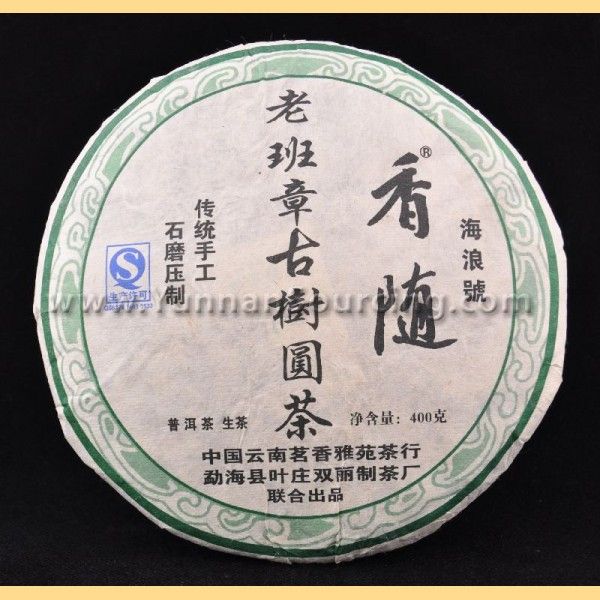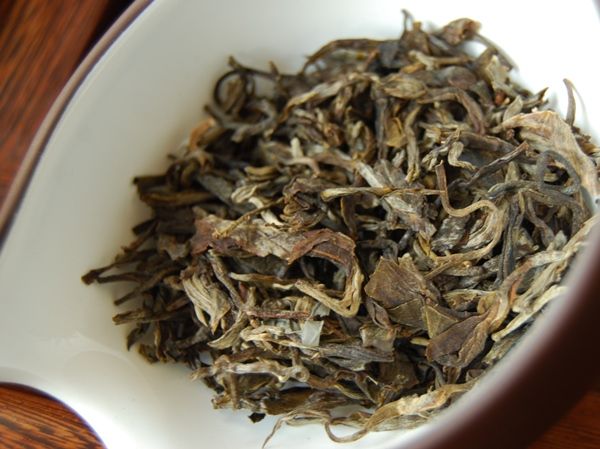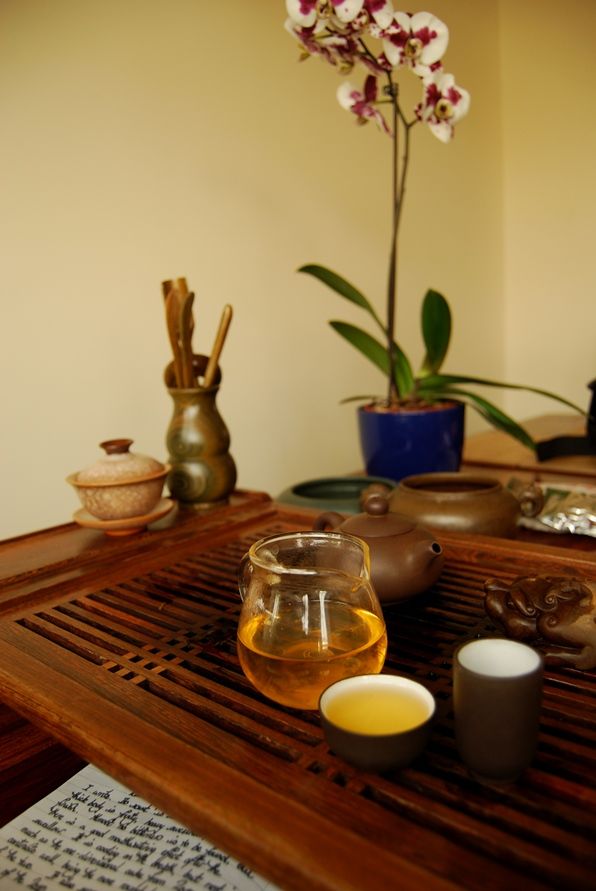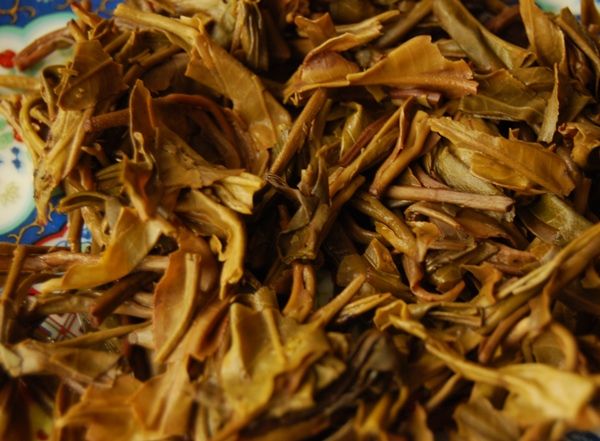I refer the venerable Reader to my article concerning last year's cake of the same variety (which wasn't a particularly accomplished tea), the notes for which may be found here. At the time of that article, the $220 asking price was the most expensive I have encountered for unaged tea.
This 2011 cake ups the ante to $295.
I have come the conclusion that Hailanghao cakes such as these are not for pu'er enthusiasts, such as the likes of you and me.
Rather like the single extortionately-priced bottle of wine residing at the bottom of most wine-lists, which exists simply so that the drinker with the large bonus can find something to spend it on, this cake is not aiming to be good value. Instead, I conclude that Mr. Hailang is simply hoping to catch one or two "big fish", rather than sell lots of cakes to enthusiasts.
As with the 2010 cake, this 2011 has similar medium-sized leaves, pictured above. They share the fresh, mint-like aroma that I previously noted.
The soup turns out to be a welcome yellow colour, which gradually turns orange as I write in my diary. This is, in fact, a good tea - unlike last year's version. It is big in the mouth, with a heavy, thick body that conveys a solid sweetness and finishes cleanly. Like some better "LBZ" maocha I have encountered, it has very little bitterness in the finish, although it does swell nicely and causes the mouth to water.
This is a more rounded, well-balanced, and enjoyable cake than last year's monstrosity. It also seems to be absent the unwelcome sour tang of its predecessor.
Being unused to caffeine of late, due to drinking various herbal whatnots in my office, this tea has a direct and immediate effect on me, which is heavy and comforting.
In the product description, Scott of Yunnan Sourcing writes that "it is more about the sensations that it gives, rather than its flavour." Were I feeling uncharitable, I would hazard that this is merchantspeak for a cake that is pleasant and refined, and yet not exceptional, but which has a good deal of caffeine and other physiology-affecting compounds.
During the fifth infusion, it has dwindled into a sweet gentility. I would, at this point, have trouble picking this tea out of a line-up of fifth infusions from other Laobanzhang cakes that are one-third of its price.
It is good, clean, well-balanced and enjoyable, being made from leaves of obvious quality. The price is such that three cakes cost the same as an '88 Qingbing, one of the most famous of the commonly-available cakes. $80, perhaps a shade more, is a price that, in my estimation, reflects its charms. $300 is, as always with Hailanghao from recent years, barking mad.
I'd love to know who buys these. The fact that they exist suggests that someone must be doing so...





15 comments:
Hah Ill have to order a sample of this tea.. Ive had a sample from 2010 HLH Lao Ban Zhang and I liked it very much. When young, Lao Ban Zhang is usualy very bitter (for some people very unpleasantly) But I like that kind of taste, reminds me of whisky :-) The thing with the price is that pure mao cha from Lao Ban Zhang(expecialy from ancient arbors) is very expensive... Even Douji tea factory stopped the production of pure Lao Ban Zhang for its price.. I would recommend to try some teas from villages that are close to LBZ- you dont pay for the name and fame of LBZ. Try to look for this tea http://natureandtea.blogspot.com/2011/07/dragon-from-bulang-and-two-teacups-from.html it comes from Zdenek Prachars Longfeng.cz
Hey Hobbes,
Agree the price is crazy. That said, there is no way they could sell the bings for $80 this year. If it is pure LBZ gushu, the price was about 1500rmb per kg when I first went to LBZ in April. A couple days later it was 1800rmb/ kg. Needless to say we didn't buy, Lots of other great teas for fraction. But $80 LBZ cakes are unicorns of the pu'er world now.
-DP
Dear Branislav,
Thanks for your comment. You know, I don't know if I agree with you when you state that young Laobanzhang is usually very bitter. Certainly the laoshu Laobanzhang that I've tried from a few sources are noticeable in the absence of their bitterness. There is activity and a heavy huigan, but no real kuwei. In taidicha, I would agree with you.
You mention that the villages around Laobanzhang, which is excellent advice. Laoman'e and Xinbanzhang are both very tasty, for example.
Toodlepip,
Hobbes
Dear DP,
1,800 RMB/kg translates into (very) approximately 600 RMB/cake, or around $95. The Hailanghao price of $295 is therefore a mark-up to 300% of the cost of its materials, which is bordering on the unethical, in my opinion. That minimum of 300% assumes, perhaps generously, that the cake is entirely made of laoshu leaves. If it is "cut" with other leaves, the mark-up increases proportionally. I'll leave it as an exercise for the reader to determine if that is true. :)
Toodlepip,
Hobbes
Hey Hobbes,
Thanks for the reply. Again, I agree the price is too high for the cake.
That said, it would be more like 720rmb per bing if you count the fact they are 400g bings. Additionally, when you buy a kg of maocha, not all of it goes in a cake as they will remove some in the process. There are also fees associated with going to pick the out the maocha (travel and such) packaging, pressing, shipping etc, but yes... $300/ cake is too much.
I just wanted to say $80 for LBZ is impossible for this year's pure cakes. You mentioned that you couldn't pick it out of a LBZ line-up with cheaper LBZ cakes, so I just read into it that you felt it was pure LBZ. My bad if I misunderstood. I really hope HLH is cutting the cake at that price.
I don't think I have had the '11 yet. I thought I did, but now that I reflect on it, he only had pressed the Yiwu cakes when I was there. I have had the '09 (I bought it even though it is not one of my favorite LBZs), the '10 (I thought it was overpriced and passed), but I still need to try his '11.
I have had others 2011 LBZ and had maocha from the source. I will say, this year's LBZ was a bit less exciting than previous years. One reason I think was due to the rain this season. If it rains too much it can weaken the flavor, which I noticed happened with a lot of the areas in Banna when I was there in early April. It depends when he got his maocha. I don't have enough info on it. If you have any particulars, let us know.
Enjoy the weekend
-DP
meant to say... I really hope HLH is NOT cutting the cake at that price.
...still haven't figured out how to edit my comments.
-DP
Dear DP,
I had a great laoshu 2011 LBZ in Maliandao this year, which was markedly nicer than this Hailanghao version. Although the Beijing version wasn't for sale, it indicates that better LBZ is at least possible this year, and that this Hailanghao cake is not it (for whatever reason).
Toodlepip,
Hobbes
(The $80 is my estimation of how much I'd pay for something of this HLH's approximate quality, in relation to the 100% laoshu tried in Beijing.)
Hey Hobbes,
One thing I wanted to get your opinion on as it relates to LBZ prices and prices in general.
I have been talking to a couple friends that are producers here and they are all lamenting the fact that prices are going up like crazy for certain villages' maocha... We aren't the only ones complaining about prices...
I made the comment that perhaps they should stop printing the village name on their cakes, as they are just advertising their treasure chest so to speak.
In turn, tea tourists that maybe only one to buy a couple of kgs show up in the village and help push the price up. I saw it in a lot of the well-known villages, but it is happening more and more often in some of the up and coming places as well.
Also, competitors that may not have visited those villages before are going in there and trying to snatch up whatever they think is the next big pu'er hotspot.
In turn, the producers have to raise their price to us and we are left scratching our heads as to how the price get so high so fast.
I know some will say it benefits the farmers, but then we lament the fact that with their increased wealth they start developing like crazy in their villages and surrounding area. Add to that how fast wealth seems to attract underhanded people, and some of the less reputable among them will come and try to exploit the area and it's name.
Like you mentioned cutting the cakes with cheaper material (tai di), or using an all together different area like is happening with cakes sold as Gua Feng Zhai, Ban Zhang, Bing Dao, etc...
I mean, I personally like the fact that I can put this flavor of tea with a village name, but if it would help cool the market, I am all for going back to naming cakes by numbers or giving them names "Chun Hua" or whatever. I mean, if you drink a cake and you like it, isn't that what matters?
Having a village name on the package doesn't really tell us if the tea we are drinking has used pesticides, is pure vs blended or anything. Our tastebuds do that. I for one vote that the producers go back to keeping it secret and if we like the cake, we can talk about the cake and we can buy more from them next year. Hopefully, if the producers don't advertise what they put into it, it will keep competitive producers, tea tourists, etc from pushing up the prices.
-DP
Hey Hobbes,
Thanks for the reply. Interesting about the Maliandao LBZ. Too bad they weren't selling it. I wonder what the price would have been. If you are in contact with whomever you tasted the cake with, please ask them when they bought the maocha. I would be interested to see if it was earlier or later in the season.
-DP
Dear DP,
I just followed your link and realised that you are the author of "The Tea Urchin" which I have been enjoying reading lately - keep up the great work! It's not often we get to read about trips to Yunnan.
The price inflation is a pain, and leads to bubbles as we've seen in everything from housing to (heh) the price of garlic. However, it surely does represent the fact that some places grow great tea, and I do like trying to find good examples from areas that I like. If we have a CNNP-style generic wrapper, it's going to be a lot harder for me to find my favourite variety. :)
It is my hope (and most of our hopes, I'm sure) that this will end in some sort of name-control system, such as the AOC/DOC used in Europe, which works well. The farmers can charge a higher price, the consumers can take confidence that they're getting well-regulated supplies. Taking one of my favourite examples, cheese, you can only use an AOC label if your herd are of a specific type of local animal, and if they are bred and raised in a certain way. It's a good way of avoiding negative effects. If you start to use unpleasant chemicals, you're (ultimately) going to lose your capacity to mark your cheese as AOC Roquefort, or your tea as AOC Guafengzhai.
Wind the clock forward a decade or so, and the PRC might be in this position. It will take a while, given all of the usual economic fun-and-games with which we're familiar, but it seems almost inevitable. The fact that Laobanzhang has tried to wall itself off, and searches incoming vehicles for imported leaves, is an indication that people are beginning to put the prototype structures and institutions in place to protect their produce. (The veracity and efficacy of these initial measures isn't the point!)
In the meantime, maybe we can hope that tea producers after a good deal will go to some of the non-inflated areas. I like Scott's Yunnan Sourcing cake from Wuliangshan very much, and the maocha was very reasonably priced. Likewise, my new teachum in Beijing Taochaju had some very reasonably-priced Nannuo and Mengsong leaves this year, which allow him to put out a 150 RMB bing which is predominantly laoshu material.
It's all good fun, is it not? :)
Toodlepip,
Hobbes
Eh... I have a link? LOL... I am not the teaurchin though. He is Asian Autralian and I am not. I follow his blog as he is one of my good friends here in Shanghai and you can actually see me in a couple of pics on his blog from the Spring Yunnan trip. He's actually in Yunnan again now... been there a few weeks. I missed going on the trip this time as I am stuck home in Shanghai with a pregnant wife.
Housing prices... yeesh... don't get me started. Luckily, I bought my house here a little over 4 years ago. Still high, but not crazy like now. Let's hope the pu'er bubble doesn't inflate like Beijing and Shanghai housing.
Anyway, I know Eugene follows your blog as well and will be pleased to see that you read his.
Ah yes, I'm being thick! You "follow" his blog, and don't write it - I should read more carefully. :)
Pregnancy is a great time. As long as you can avoid being punched in the face, as a husband, you're winning. -__-
One of our collaborators lives and works within the "erhuan" of Beijing, in the Xichang financial district, and recently disclosed the rent that he pays for his flat. You could buy many tong of 88 Qingbing per month, let's say. :)
Toodlepip,
Hobbes
I am quite envious of your tea-ware. Do you know where I can find something similar, and not break my wallet?
Thank you
Hi, Alan,
You know - the little white cups are just inexpensive examples that are available from most places. I bought them in China, but they're very plain.
The teapot is a little more special, for which I hunted in Maliandao for ages. My wife ended up buying it on a trip to Beijing while I wasn't there. I'm not sure about buying teapots via the Internet, without the ability to touch them and examine them first.
There are plenty of good tea-trays and chadao (the pot of utensils) available. I bought mine in China, after much shop-hunting, but Dragon Teahouse sells nice trays (I like Hengfu's trays) and everyone seems to sell nice chadao.
Let us know how you get on! Remember to buy slowly - teaware stays with you for ages (hopefully, for life) and so you need to make sure that you're buying the right teaware to suit your needs and tastes. And wallet. :)
All the best,
Hobbes
Post a Comment